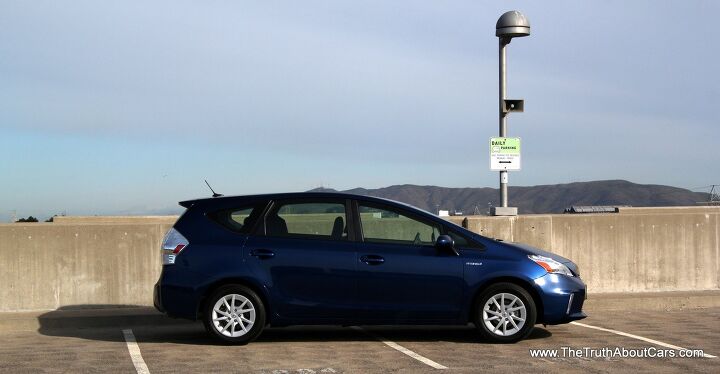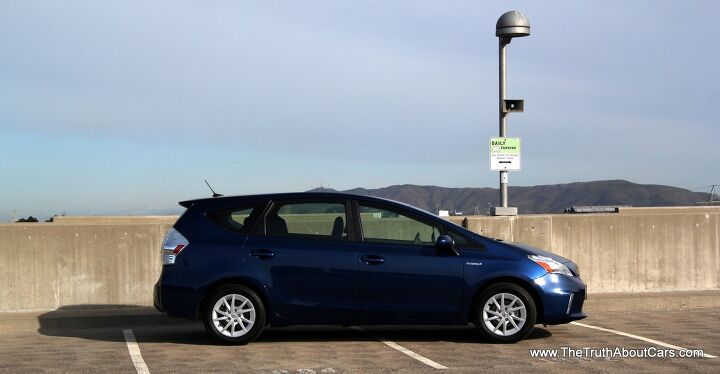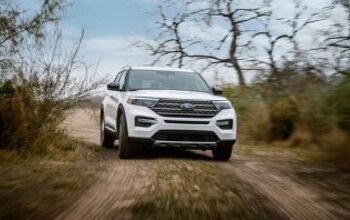Commercial Week Day Five Review: 2012 Toyota Prius V – Take Two

It’s the end of our commercial week and there’s a hybrid staring you down. No, the Prius v isn’t really a commercial vehicle, but there is a good reason it’s jammed in to this week of cargo haulers: 44 miles per gallon around town. Our own Michael Karesh snagged considerable seat time at a launch event last June, but pricing hadn’t been released at that time. So how much does it cost and what’s it like to live with for a week? And most importantly, is it any good at hauling cargo instead of kids?
When you think about it, using a station wagon as a cargo hauler isn’t that crazy of an idea. Although it is considerably shorter than a full-size van, exterior dimensions are actually in the Prius v’s favor. At 182 inches long, it is two inches longer than Ford’s Transit Connect, and the stubby hood means more interior room. Aesthetically the Prius v looks like a Prius that’s been eating too may doughnuts. Despite the broader proportions, the shape is undeniably Prius and even with a full-body vinyl wrap, the shape will lend some green-cred to your business venture.
The Prius v borrows from the Prius family parts bin and style wardrobe, but because of the increased size of the vehicle inside and out little is directly shared with the liftback save for the steering wheel and switch gear. The v ditches the Prius’ funky “bridge” center console for a more traditional shape and shares its infotainment options with both the Prius c and the Prius liftback. The differences are greater in the rear where the reclining rear seats also move fore/aft to increase the cargo area at the expense of rear seat leg room (a handy trick for IKEA runs.)
The Prius v is offered in three different trims, the base Prius v Two comes with standard bluetooth phone and USB/iPod integration, a backup camera, keyless entry on the driver’s door, keyless go and a 6.1-inch touchscreen radio. The “Three” model adds the basic voice command navigation system with the same 6.1-inch screen, and entune data services like traffic, weather, fuel prices etc for $765. The top end “Five” trim (no, I have no idea what happened to One and Four) adds pleather seating, keyless entry, LED headlamps, foglamps, and some snazzier 17-inch wheels with slightly wider rubber for $2,825 more than the “Three”. The Five also allows you to option your ride up to the hilt with optional radar cruise control, JBL sound system and the premium 7-inch navigation system which is shared with most large Toyota and Lexus products. It’s also the only way to get a moonroof in your Prius wagon. The only way to get the moonroof in the Five is to add the “Advanced Technology Package.” Ouch.
With a hair more cargo capacity than a Ford Escape Hybrid, cargo is clearly the v’s raison d’être, providing 67.3 cubic feet with the rear seats folded and 34.3 with them in place. Of course, those numbers pale in comparison to the 130 cubic widgets the Transit Connect will haul, however, Toyota tells us that removing the front and rear passenger seats is a cinch and will convert the v into a 105 cubic foot hauler. For long cargo that’s not too tall. The resulting oddly-sized space is about 25 cubes smaller than the Transit Connect, and payload only increases to around 1,100-1,200lbs with these modifications compared to the 1,600lb payload in the Transit Connect. Before you dismiss the exercise as frivolous, the pay off is quite literally twice the city fuel economy and a 50% increase in highway fuel economy. Based on our tests with 1,000lbs of “human cargo” in each vehicle, the Prius realistically delivers a 60% increase in economy vs the Transit Connect’s 25MPG actual highway numbers. (TTAC tested.)
The Prius v may not have the tall-cargo ability of the Connect, but it beats it handily when it comes to loading long items. We were able to easily load 10-foot items on the right side of the vehicle, and 11-foot items will fit from the front passenger footwell to the rear hatch at a slight angle. The Connect tops out at 10.5 feet with cargo propped up on the dash. As many have observed, the Prius v lacks a forward-folding front passenger seat, so people buying the v for family use won’t be able to utilize this extra space. Hopefully Toyota will correct that in future versions. Toyota’s fleet sales offices indicate there is considerable interest from commercial customers for the v, specifically as taxis or delivery vehicles. The commercial customer was tired of feeding 15MPG full-sized vans based on their “peak” cargo capacity needs and after an evaluation of their “average” has decided to purchase a small test fleet of Prius v moels for pick-up and delivery duties.
Powering the v is the same 98HP, 105lb-ft 1.8L four-cylinder Atkinson cycle engine found in the Prius liftback, sending power to the front wheels via a lightly revised Toyota Hybrid Synergy Drive system which bumps the power up to the same combined 134HP and around 150-160ft-lbs of torque as the Prius liftback. (Toyota does not list an official combined torque figure for their HSD systems.) While the majority of the HSD internals are shared with the liftback, Toyota added water cooling jackets to the motor/generator and shortened the final drive ratio from 3.26 to 3.7 to compensate for the added weight and improve performance when loaded with cargo. Acceleration is as leisurely as you would expect when 134 horses are asked to move 3,274lbs of Prius and one 180lb driver, with the Prius v hitting 60 in 9.34 seconds. Compared to the Transit Connect however, the Prius v manages to be faster whether empty or loaded with 5 adult passengers, thanks mostly to the electric CVT.
The Prius v has a fairly soft suspension and a fairly long 109.4-inch wheelbase which give the v a smooth ride that is very similar to the Camry hybrid. When the going gets twisty the Prius v’s suspension does an admirable job of keeping the pregnant Prius planted, but the low rolling resistance tires ultimately limit adhesion. While the Prius v scores about as well as many entry-level mid-sized sedans on the skidpad it is much more stable than any of the cargo haulers we have looked into this week and provides more standard safety features to boot. While the NHTSA has yet to test the Prius v for a government star rating, Toyota expects it to receive 5 stars and they are likely right as it earned a Top Safety Pick award on the more stringent IIHS tests. The Transit Connect on the other hand, ranked a lowly two stars overall because of its poor performance in front and side impacts despite being equipped with standard side airbags.
With a starting price of $26,400, the Prius v is $2,400 more than the Prius liftback and $500 more than the 200HP Camry hybrid. Placed up against that competition, the v seems outmatched by the Camry’s performance and the Prius liftback’s 7/8MPG better fuel economy. The v then should appeal to shoppers who wish that really just want a hybrid Camry wagon since dimensionally, the v is about the same size.
On the cargo front the Prius v becomes a more attractive proposition. With a solid 42MPG combined EPA score and our 805 mile average of 43.1MPG, the Prius v literally uses half the gasoline in our testing cycle as the Transit Connect. Equipping the Connect with rear windows and a backup cam (standard on the Prius v) brings the price of the baby Ford to $24,800, just $,1600 less than the Prius v. Depending on your business type and your local gasoline prices, the Prius v would start saving you money compared to a Transit Connect after only 16 months. Downsizing further, the v is actually about $2,00 cheaper than a V6 cargo van from GM. Considering the v’s reliability reputation, fuel consumption, and the ever-increasing cost of gasoline out here on the “left coast,” maybe adding a some Prius love to your fleet isn’t such a crazy idea after all.
This is part five of a five-part series on commercial vehicles. Click the links below for the others in this series
2012 Chevrolet Express / GMC Savana
Toyota provided the vehicle, insurance and one tank of gas for this review
Specifications as tested
0-30: 3.09 Seconds
0-60: 9.32 Seconds
1/4 Mile: 17.13 Seconds @ 79.5MPH
Average fuel economy: 43.1MPG over 806 miles

More by Alex L. Dykes
Latest Car Reviews
Read moreLatest Product Reviews
Read moreRecent Comments
- Akila Hello Everyone, I found your blog very informative. If you want to know more about [url=
- Michael Gallagher I agree to a certain extent but I go back to the car SUV transition. People began to buy SUVs because they were supposedly safer because of their larger size when pitted against a regular car. As more SUVs crowded the road that safety advantage began to dwindle as it became more likely to hit an equally sized SUV. Now there is no safety advantage at all.
- Probert The new EV9 is even bigger - a true monument of a personal transportation device. Not my thing, but credit where credit is due - impressive. The interior is bigger than my house and much nicer with 2 rows of lounge seats and 3rd for the plebes. 0-60 in 4.5 seconds, around 300miles of range, and an e-mpg of 80 (90 for the 2wd). What a world.
- Ajla "Like showroom" is a lame description but he seems negotiable on the price and at least from what the two pictures show I've dealt with worse. But, I'm not interested in something with the Devil's configuration.
- Tassos Jong-iL I really like the C-Class, it reminds me of some trips to Russia to visit Dear Friend VladdyPoo.













































































Comments
Join the conversation
Wanted to advise one error in this otherwise well put review. The front passenger seat does allow for "long cargo mode". In order to set up for this use simply remove the headrest and recline the seat all the way back. It will be level with the rear seat which is as good as a fold flat front passenger seat back.
Good idea to take the "v" and make a cargo van with . But... I buy myself a Kia Rondo 2011 for 18800 $ ( cdn dollars ) brand new ( all tax in ) dump the rear seat and lowering all the rear floor to increase the standard 74 cbic feet of rear cargo. Go to youtube and click over " Kia Rondo Cargo van at the cias 2011 " and you can see that a Cdn company offers a conversion without however lowering the rear floor like I do . A base Ford Tc and a base Prius V are about the same price here in Cdn . Roughly 30000 $ with all the tax and destination charge . So it's gonna take 9 years just in fuel to amortize the superior price of an holding value Prius, compare to my cheap Kia . Maybe I gonna lost at the end but for many people the initial expense is an important thing for starting a small business, no matter if you got a small gaz guzzler like my Rondo 2.4 . Just hope the "V" could came here with the more efficient & compact battery pack the Euro version get. This way a conversion like mine ( lower rear cargo area ) could eliminate the remaining bump in front of the rear underfloor compartment and behind the rear seat . Toyota should sell an allready cargo version of the "V" like Chevy was doing with the late panel HHR ( ...but dump those awful plastic underfloor bins who eat vertical dimension ).